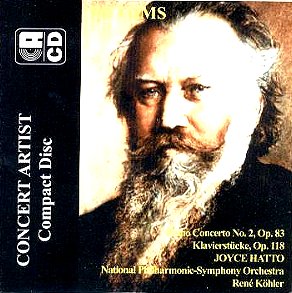The musical world moves in strange ways. When invited
to review a series of recordings by Joyce Hatto I accepted more or less
out of idle curiosity. I remembered that a pianist of that name had
recorded some Bax well back in the LP era for a little-remembered label,
and supposed these were recordings made around the same time that somebody
had seen fit to unearth. The label itself aroused my curiosity, for
alongside memories of Concert Hall and their pioneering Bax 4 with Handley
and the Guildford Philharmonic, were not Fidelio among the first to
put bargain-price records on the market, only to be hopelessly swept
away as the majors realised the potential of their back catalogue in
this field? But all this, I thought, belonged to the dim and distant
past, the labels and their artists having long since disappeared from
view (except Handley, of course).
Nothing could be further from the truth. The label
was founded in 1952 (you can read the full story at the website above)
and has always remained in existence. From its first issues on 78s it
has moved with the times; its CD catalogue is extensive and enticing,
it maintains a full cassette catalogue at a time when the big companies
are issuing only the most popular repertoire in that format, and it
is a firm believer in the potential of the mini-disc.
All the same, I remain puzzled. Where has it been
all these years? How is it possible for a company to issue all this
repertoire with practically nobody being aware of it? How many records
do they actually sell? With giants like EMI claiming that classical
CDs just lose money, have they found the magic fount? Or is some wealthy
patron of the arts down at Royston, Hertfordshire in rural England happy
to amass a catalogue, with the question of sales an optional extra?
And where has Joyce Hatto been all these years? For
these are not old reissues at all. Over the past decade this pianist
has been in and out of the studios, recording the complete Beethoven
sonatas, the complete Mozart sonatas, all Chopin, all Schumann, plenty
of concertos with this same (pseudonymous?) orchestra and conductor,
lots of Bach, lots of Liszt; again, take a look at the website for a
full list.
So who is Joyce Hatto? Well, she studied composition
with Seiber and Hindemith, and piano with Cortot, Nadia Boulanger, Drzewiecki
(in Warsaw) and Ilona Kabos (in London), and she has played under De
Sabata and Beecham as well as the composers Orff, Britten, Vaughan Williams
and Malcolm Arnold. Since De Sabata retired from conducting in 1957
and Vaughan Williams died the following year, my curiosity as to her
age is probably rather ungentlemanly but the mystery remains. If she
has been playing around the world all these years (yet again, visit
the website to read her curriculum), why is the world so little aware
of her?
Because, you may be thinking, she is not especially
good. Well, however she may have played in her earlier years, in her
maturity she is unquestionably a very fine pianist indeed, whose discs
(to judge from the first two I have heard), will repay the closest study.
The op. 118 pieces are a locus classicus of how this music should
go. The sound is mellow and songful, full when needed but never heavy,
the inner accompanying figures somehow filling the air with notes without
ever dominating over the melodies. The tempi move easily (no. 1 is richly
passionate but not overdriven, no. 2 is not allowed to drag). Is it
a little too autumnally reflective? Hardly so when the elusive
no. 4 is invested with such tragic passion (Concert Artists were evidently
so proud of this performance that they put it on the disc twice over).
Nor is there any emotional short-changing in no. 6, one of Brahms’s
starkest utterances. Those used to Julius Katchen’s gentle way with
no. 5 will be surprised at Hatto’s full-toned, forward-moving opening,
but in fact Brahms wrote espressivo without any dynamic marking
(the theme is marked piano when it is repeated 8 bars later)
so Hatto’s guess is as good as Katchen’s. In general I much prefer her
performances to Katchen’s, highly regarded though they are, since Katchen’s
undoubted insights reach us through such a maze of expressive nods and
nudges that I can hardly sit out a single piece from him.
Whether the concerto is on quite the same pedestal
will depend rather on your reaction to the first movement. During the
orchestral introduction it seems woefully slow; yet when Hatto enters,
how full of notes the music is even at this speed. In fact, Hatto’s
richly commanding playing lets us hear details that are often brushed
over and the tempo sounds perfectly natural when she is playing. The
orchestra (a perfectly good one) doesn’t quite manage this. Is it because
the tempo is wrong or because the conductor, though evidently an able
musician, is not on Hatto’s same level? She should have recorded it,
maybe, with Kurt Sanderling in his late phase.
The remaining movements are more "normal"
in their tempi and Hatto’s pianism is always to be enjoyed. However,
to bring off a Brahms concerto successfully you do need a partnership
of the highest level and my feeling at the end was that the music had
run its course well without the pair quite striking sparks off each
other. This is a performance I shall return to, but not a first recommendation.
However, Joyce Hatto is a pianist who demands to be heard and the op.
118 pieces are alone worth the price of the record. The recordings are
warm if a little lacking in presence at climaxes.
see also
review
by Jonathan Woolf
JOYCE
HATTO -
A Pianist of Extraordinary Personality and Promise:
Comment and Interview by Burnett James
Christopher Howell
